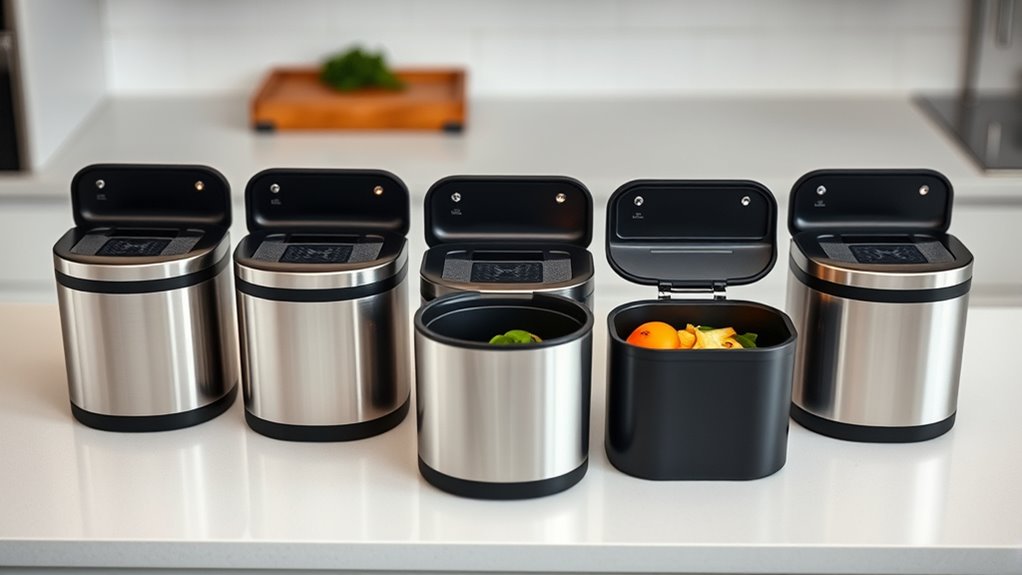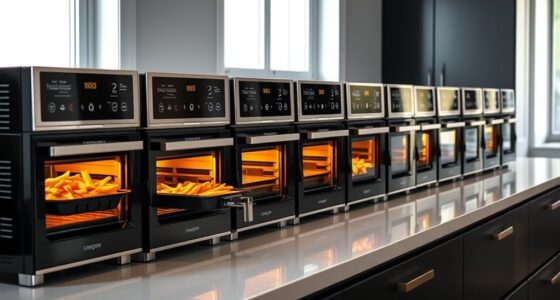If you’re looking for the best electric compost bins for your kitchen in 2025, I recommend checking out options like the CREATIVECHEF electric composter, compact models with odor filters, and those with auto-cleaning features that turn food waste into fertilizer quickly. These models operate quietly, have the right capacity, and keep odors at bay. To make an informed choice that suits your needs, you’ll find more helpful details by exploring the options below.
Key Takeaways
- Features quiet operation (42–46 dB), auto-cleaning, and odor control for a hassle-free, odorless kitchen composting experience.
- Capacities range from 2.5L to 3.8L, balancing space efficiency with waste processing needs.
- Rapid composting in 3–6 hours with turbo modes and temperature control enhances convenience.
- Compact, stylish designs fit seamlessly into various kitchen setups while maintaining hygiene through removable, dishwasher-safe parts.
- Consider capacity, odor management, noise levels, cleaning ease, and composting speed when selecting the ideal electric compost bin.
CREATIVECHEF Electric Composter (3.8L Indoor Smart Odorless Compost Bin)
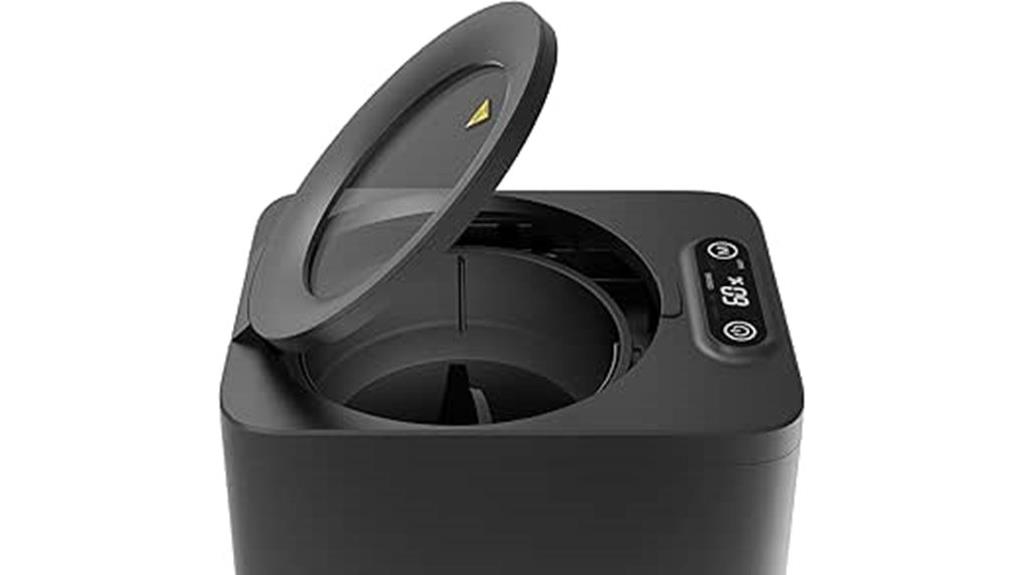
If you’re looking for an easy, odor-free way to manage food waste indoors, the CREATIVECHEF Electric Composter is a great choice. Its 3.8L capacity makes it perfect for daily kitchen use, and the visual cover helps you monitor the composting process. It operates quietly at just 46 dB, so it won’t disturb your home. The device converts food scraps into dry compost, reducing waste and helping the environment. With activated carbon filters, odors stay at bay. Plus, the auto-clean mode makes maintenance simple—just add water, lock the lid, and press a button. It’s compact, efficient, and user-friendly.
Best For: individuals seeking an easy, odorless, and compact indoor composting solution to reduce kitchen waste efficiently.
Pros:
- Quiet operation at just 46 dB, suitable for household environments
- Large 3.8L capacity allows for less frequent emptying and higher waste handling
- Auto clean mode simplifies maintenance and ensures hygiene
Cons:
- Limited capacity may not suffice for larger households with high waste production
- Plastic and stainless steel construction may be less durable than full metal options
- Customer ratings are mixed, averaging around 3.9 stars, indicating some users may experience issues
3L Electric Composter for Kitchen, Smart Compost Bin, Odorless, Low Noise, Auto-Cleaning, Fast Food Waste to Fertilizer Conversion

For anyone looking to turn kitchen waste into nutrient-rich compost effortlessly, the L Electric Composter offers an ideal solution. Its compact, stylish design fits perfectly on any countertop, making it easy to place anywhere. The built-in odor-filtering system with activated carbon keeps your kitchen smelling fresh, while the auto-cleaning feature saves time by removing residues with just a press of a button. With quick and standard modes, it transforms food waste into dry fertilizer in just 4–6 hours. Operating quietly at no more than 42 dB, it’s user-friendly and perfect for daily use without disturbance.
Best For: individuals seeking an efficient, odorless, and compact solution for converting kitchen waste into nutrient-rich compost effortlessly.
Pros:
- Space-saving, stylish design fits seamlessly into any kitchen environment
- Odor-filtering system with replaceable activated carbon maintains a fresh kitchen atmosphere
- Auto-cleaning feature simplifies maintenance and saves time
Cons:
- Limited capacity of 3L may require frequent emptying for larger households
- Quick mode produces compost in 4–6 hours, which might not suit all composting needs
- Noise level of up to 42 dB, which could be noticeable in very quiet environments
Vitamix FC-50 Food Processor and Recycler
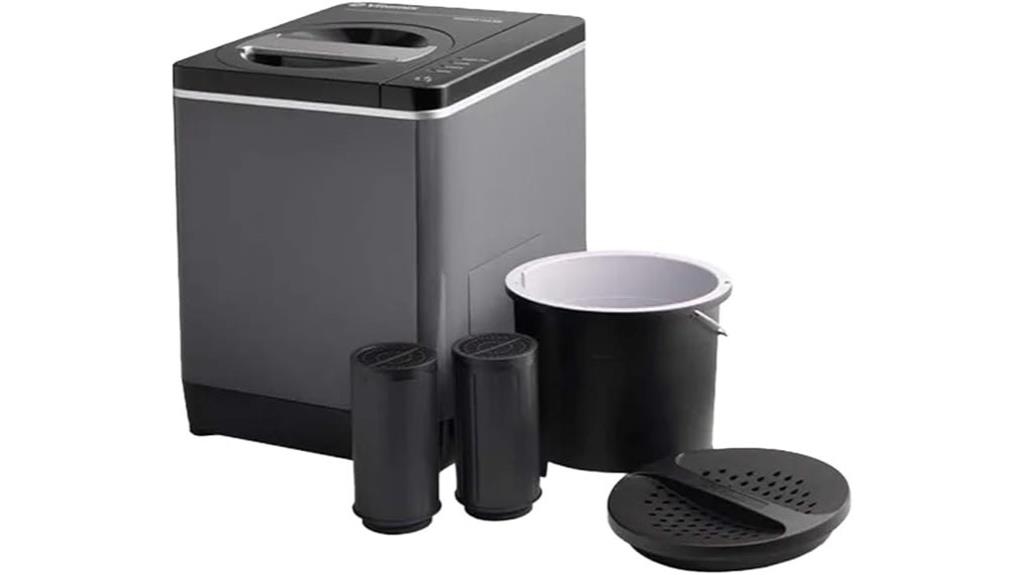
The Vitamix FC-50 Food Processor and Recycler stands out as an ideal choice for eco-conscious households seeking a compact, efficient waste management solution. It transforms food waste into nutrient-rich soil within hours, helping reduce landfill contributions. Its powerful carbon filter lid minimizes odors, keeping your kitchen fresh, while the whisper-quiet operation ensures seamless use during daily routines. With a 2.5L capacity and a compact design, it fits easily in kitchens or storage areas. Simple to operate, it features a one-touch start and intuitive LEDs, making sustainable waste recycling accessible for everyone. This device combines convenience, eco-friendliness, and discreet performance in one sleek package.
Best For: eco-conscious households seeking a compact, efficient, and quiet waste management solution that transforms food waste into nutrient-rich soil.
Pros:
- Converts food waste into soil within hours, reducing landfill contributions
- Equipped with a powerful carbon filter lid to minimize odors effectively
- Operates whisper-quietly, seamlessly fitting into daily routines
Cons:
- Limited to food waste processing; not suitable for non-organic waste
- Requires regular maintenance of the carbon filter to ensure odor control
- May be less effective for large quantities of waste due to its 2.5L capacity
4L Electric Composter for Kitchen with Auto-Cleaning and LED Display
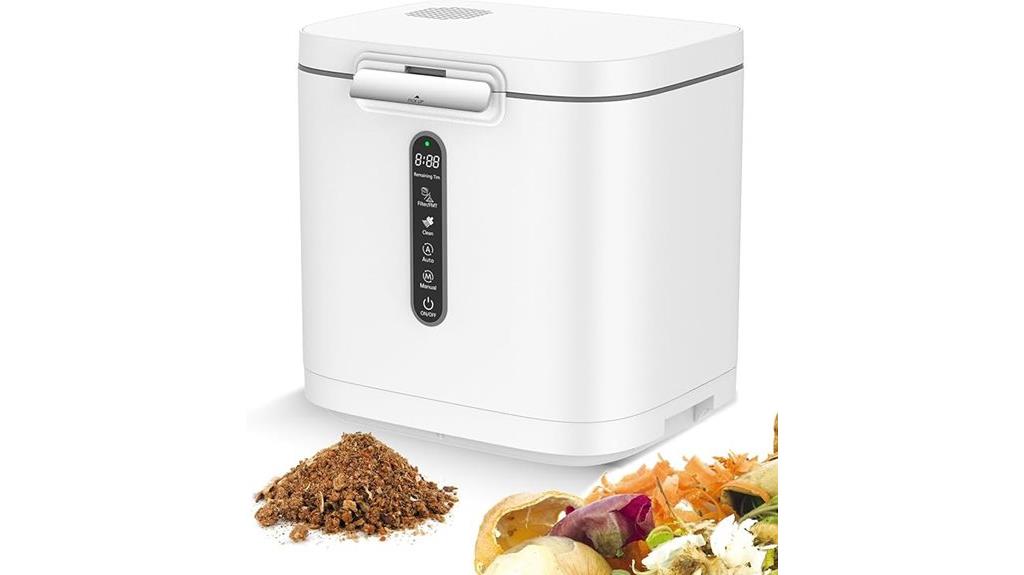
Designed for busy homeowners who want hassle-free composting, the 4L Electric Composter features an intuitive LED display and automatic cleaning functions that make kitchen waste management effortless. Its compact size fits easily on countertops or in outdoor spaces, handling daily scraps efficiently. With a powerful six-blade churning system, it turns food waste into dry fertilizer in just 3-6 hours, reducing waste volume by 90%. Odor control is seamless thanks to activated carbon filters, while the removable, dishwasher-safe parts simplify cleaning. The smart interface shows composting modes, remaining time, and auto-cleaning status, making composting quick, clean, and convenient.
Best For: busy homeowners seeking an efficient, odor-free, and hassle-free kitchen composting solution with minimal maintenance.
Pros:
- Fast composting cycle of 3-6 hours with 6-blade churning system.
- Automatic cleaning and odor control features enhance convenience and indoor air quality.
- Compact, stylish design with LED display for easy operation and monitoring.
Cons:
- Limited 4-liter capacity may not suit larger households or high waste volumes.
- Requires electricity and may be less suitable for outdoor use in extreme weather conditions.
- Slightly heavy (13.06 kg) for portability, which could be inconvenient for some users.
Electric Composter for Kitchen, 4L Smart Indoor Food Recycler
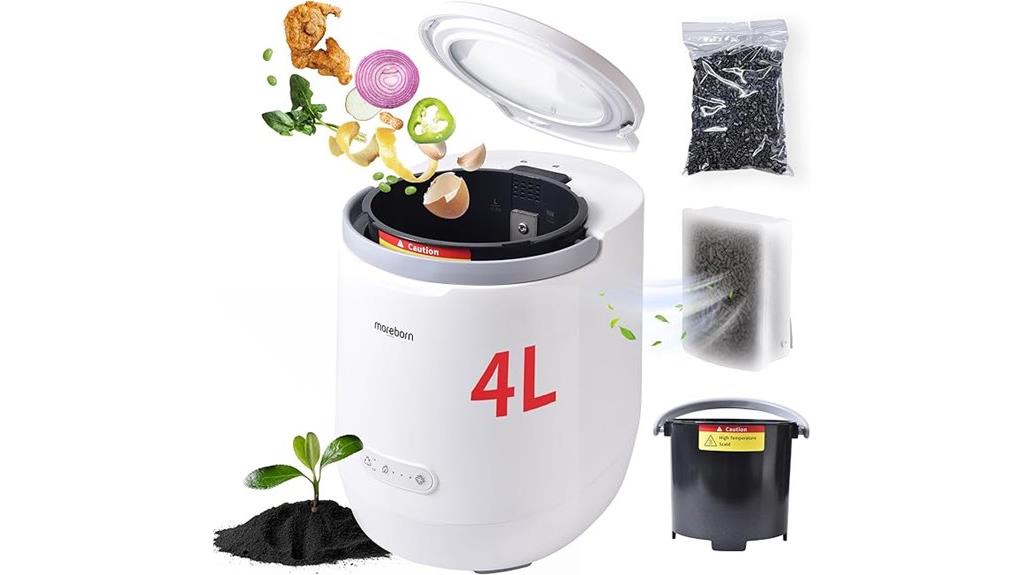
If you’re looking for an efficient way to manage kitchen waste indoors, the Electric Composter for Kitchen, 4L Smart Indoor Food Recycler stands out with its smart features and compact design. It processes daily waste with just 0.7kWh per cycle, making it eco-friendly and reducing your carbon footprint. The device offers dual modes: dry waste recycling and composting for fertilizer. Its turbo mode reduces waste volume by 90% in four hours, shredding bones and fibers quietly below 38dB. Odor control is excellent, thanks to a jumbo carbon filter trapping 99% of smells. The self-cleaning function and dishwasher-safe bucket make maintenance effortless.
Best For: busy homeowners and urban dwellers seeking an eco-friendly, indoor solution for managing kitchen waste with minimal odor and maintenance.
Pros:
- Eco-friendly operation with low energy consumption of 0.7kWh per cycle
- Effective odor control thanks to jumbo carbon filter trapping 99% of smells
- Compact, quiet, and easy to clean with self-cleaning and dishwasher-safe features
Cons:
- Moderate customer rating of 3.2 out of 5 stars may indicate mixed satisfaction
- Limited capacity of 4L might require frequent use for larger households
- Higher price point compared to traditional waste bins without additional composting features
Factors to Consider When Choosing an Electric Compost Bin for Kitchen
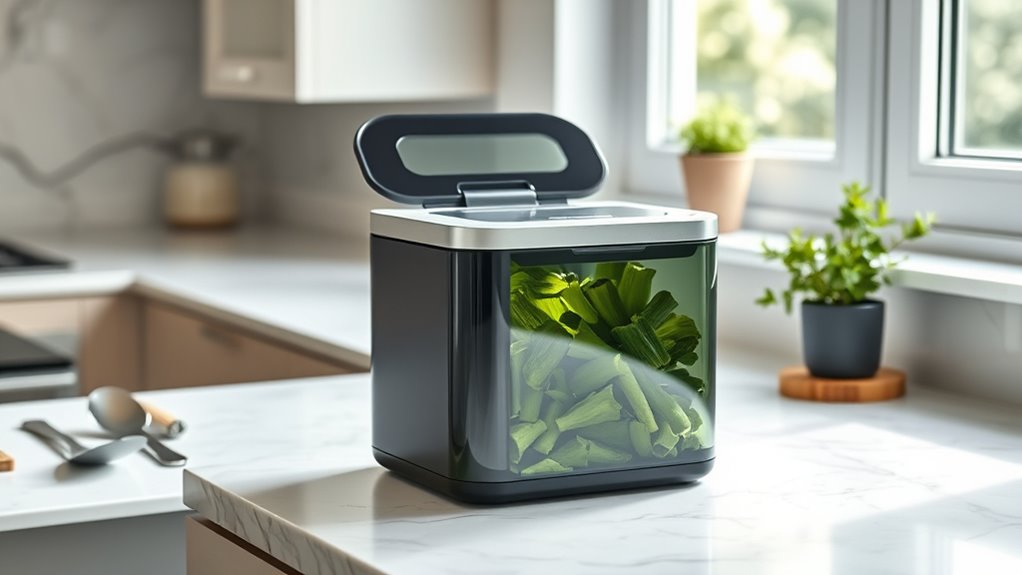
When selecting an electric compost bin, I look at its capacity and size to fit my kitchen space. Odor control features and noise levels are also key to keeping the environment pleasant and quiet. Additionally, I consider how easy it is to clean and how quickly it composts to match my busy lifestyle.
Capacity and Size
Choosing the right electric compost bin involves considering its capacity and size to match your household’s needs. Bins typically range from 2.5L to 4L, affecting how much waste you can process before needing to empty it. Larger models, like 3.8L or 4L, are ideal for households with higher waste output, meaning less frequent emptying. Smaller options, such as 2.5L or less, suit limited countertop space but require more maintenance. It’s also essential to think about the physical dimensions to guarantee it fits comfortably in your kitchen. Striking a balance between size and capacity helps you select a bin that handles your waste volume without overcrowding your space. This way, your composting process remains convenient and efficient.
Odor Control Features
Effective odor control is essential when selecting an electric compost bin for your kitchen, as it helps keep your space smelling fresh while composting. Many models use activated carbon filters that absorb and trap unpleasant smells during the process, ensuring odors don’t escape into your home. Look for bins with replaceable filters and odor-sealing lids, which are key to maintaining a fresh environment and preventing leaks. Sealed, airtight covers also play a pivotal role in containing odors, especially during longer composting cycles. For stronger or persistent kitchen smells, consider bins that offer additional filtering systems or odor-neutralizing agents. Proper maintenance, like regular filter replacements and cleaning, is fundamental to keep odor control effective over time, ensuring your composting experience stays odor-free.
Noise Levels
Since noise levels can vary considerably between models, it’s important to evaluate how loud an electric compost bin gets during operation. Most operate between 38 and 46 dB, roughly comparable to a quiet library or soft conversation. Lower noise levels, around 38-42 dB, are ideal for overnight or daytime use, especially in quiet households, to prevent disturbances. If a bin exceeds 45 dB, it might become noticeable and disruptive, particularly in open-plan or noise-sensitive spaces. Many modern models include noise reduction features or insulation to keep sound levels down. Keeping noise considerations in mind helps maintain a peaceful kitchen environment, especially if the bin is used in shared or multi-use areas. Choosing a quieter model ensures your composting process doesn’t interfere with daily activities.
Cleaning Convenience
When selecting an electric compost bin for your kitchen, cleaning convenience is a top priority. Look for models with auto-cleaning features that automatically rinse and clean after each use, reducing manual effort. Removable, dishwasher-safe buckets make it easy to wash and reuse parts without tedious scrubbing. Devices with one-touch cleaning buttons allow quick, effortless cycles, saving you time and mess. Built-in filters and odor-control systems help manage smells, decreasing the frequency of deep cleaning. Additionally, quiet operation levels below 45 dB ensure that cleaning processes don’t disturb your household. These features collectively simplify maintenance, making it easier to keep your compost bin fresh, hygienic, and odor-free without hassle. Prioritizing cleaning convenience ensures your composting experience remains smooth and enjoyable.
Composting Speed
Choosing an electric compost bin that speeds up the process can make a big difference in how quickly you see results. Look for models with turbo or quick cycle options, which can turn food waste into compost in just 4 to 6 hours. High-temperature processing features accelerate decomposition, considerably reducing waste volume fast. The size of the bin’s chamber and its shredding or churning mechanisms also influence how quickly compost is produced. Automated functions like auto-cleaning and continuous mixing help keep conditions ideal for rapid composting. Additionally, effective temperature control and good aeration are essential, as they promote faster organic breakdown. Prioritizing these speed factors ensures you get nutrient-rich compost quickly, making your kitchen waste recycling more efficient and satisfying.
Energy Efficiency
Selecting an energy-efficient electric compost bin involves examining its power consumption and operational features to save electricity and reduce costs. I look for models that use around 0.7 to 0.9 kWh per cycle, which helps minimize energy use. Features like auto-cleaning modes also matter, as they reduce manual effort and save electricity. Quick composting cycles, typically within 4 to 6 hours, are ideal because they limit prolonged energy consumption. I also consider bins with intelligent or adjustable modes that optimize energy use based on waste volume and composting needs. Finally, I check the device’s noise level and power rating to guarantee it operates quietly and consumes minimal energy during daily use. These factors help me find an eco-friendly, cost-effective option.
Price and Warranty
Price and warranty are critical factors that can influence your overall satisfaction with an electric compost bin. I recommend comparing the price relative to features, capacity, and brand reputation to guarantee you’re getting good value. Look for models with a solid warranty, such as 36 months, which offers peace of mind against defects or malfunctions. Some brands even provide a 60-day money-back guarantee, allowing you to test the product risk-free. It’s also smart to check the warranty details and customer support options, so you’re confident help will be available if issues arise. While higher-priced models might include extended warranties or extra features, weigh these benefits against your budget and needs. Ultimately, the right balance ensures you get a durable, reliable product without overspending.
Frequently Asked Questions
How Energy-Efficient Are These Electric Compost Bins?
Electric compost bins are quite energy-efficient, typically using only a small amount of power each day—similar to a light bulb. I find that their low energy consumption doesn’t increase my electricity bill much, and they help me compost waste faster without any extra effort. Plus, their eco-friendly operation aligns with my goal to reduce waste and minimize my carbon footprint, making them a smart and sustainable choice.
Can They Handle Large Quantities of Food Waste Daily?
Think of an electric compost bin as a busy kitchen worker—it can handle a decent amount of daily food waste, but not an endless buffet. Most models are designed for household use, so they manage daily scraps comfortably, typically up to a couple of pounds. If you generate more waste, you might need to empty it more often or consider a larger capacity. It’s a handy tool, but not a giant waste warehouse.
Are Replacement Filters or Parts Needed Regularly?
Yes, replacement filters or parts are usually needed over time, but it’s not a daily hassle. I find that filters typically last several months, depending on usage and model. Regularly checking and replacing them keeps my compost bin odor-free and functioning smoothly. Most brands make it easy to order replacements online, so I never worry about maintenance becoming a chore. It’s a simple way to keep my eco-friendly habits going strong.
Do They Emit Any Harmful Gases or Odors During Operation?
Think of my electric compost bin as a gentle garden guardian—no harmful gases or foul odors escape during operation. It’s designed with advanced filters that trap smells and neutralize emissions, keeping my kitchen fresh and inviting. I’ve found that regular filter replacements ensure it stays eco-friendly and odor-free. So, rest assured, this bin works quietly and safely, transforming kitchen scraps into compost without turning your space into a stinky mess.
How Long Does the Composting Process Typically Take?
The composting process in electric bins usually takes about 24 to 72 hours, depending on the model and the type of waste. I’ve found that consistent mixing and proper moisture levels help speed things up. Some bins even have smart features to optimize the process. Overall, it’s pretty quick compared to traditional composting, making it a convenient choice for busy kitchens like mine.
Conclusion
Choosing the right electric compost bin feels like finding a hidden gem in your kitchen routine. As I discovered, these eco-friendly marvels not only make composting effortless but also surprisingly add a touch of harmony to everyday life. It’s funny how a simple bin can turn food scraps into fertilizer, transforming waste into something meaningful. I encourage you to pick one that fits your space—you might be surprised at how seamlessly it becomes part of your eco-conscious journey.
